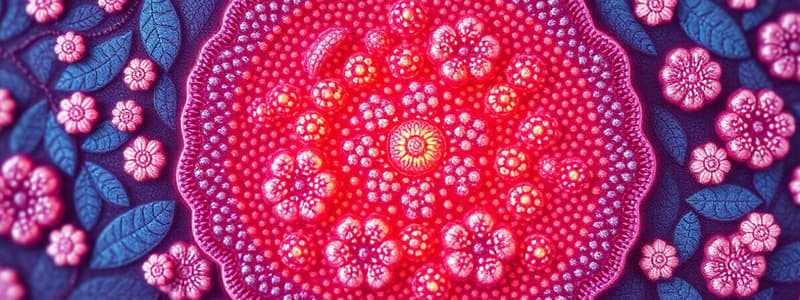Podcast
Questions and Answers
What is the primary function of epithelial tissue?
What is the primary function of epithelial tissue?
- Covers and lines body surfaces (correct)
- Facilitate communication between body parts
- Store energy and nutrients
- Support and bind other tissues
Which of the following correctly describes the characteristics of epithelial tissue?
Which of the following correctly describes the characteristics of epithelial tissue?
- Has a free surface and is avascular (correct)
- Cells are loosely bound with large intercellular spaces
- Does not regenerate under normal conditions
- Highly vascular with abundant blood supply
What distinguishes pseudostratified epithelium from simple and stratified epithelium?
What distinguishes pseudostratified epithelium from simple and stratified epithelium?
- It is exclusively columnar in shape.
- It consists of more than one layer of cells.
- It has a single layer of cells that resemble multiple layers. (correct)
- It contains only flat-shaped cells.
Which of the following tissues is NOT a primary type of tissue in the body?
Which of the following tissues is NOT a primary type of tissue in the body?
Which function is primarily associated with glandular epithelium?
Which function is primarily associated with glandular epithelium?
Which type of connective tissue is characterized by a fluid matrix and is involved in transporting materials?
Which type of connective tissue is characterized by a fluid matrix and is involved in transporting materials?
What is the primary function of muscle tissue?
What is the primary function of muscle tissue?
Which type of cartilage is described as the most abundant and has a glassy appearance?
Which type of cartilage is described as the most abundant and has a glassy appearance?
What characteristic is unique to cardiac muscle tissue?
What characteristic is unique to cardiac muscle tissue?
Which type of tissue primarily sends impulses to other areas of the body?
Which type of tissue primarily sends impulses to other areas of the body?
Which stage of tissue repair involves the formation of new, fragile tissue with capillaries?
Which stage of tissue repair involves the formation of new, fragile tissue with capillaries?
What is a common characteristic of smooth muscle tissue?
What is a common characteristic of smooth muscle tissue?
Which connective tissue type consists of tendons and ligaments?
Which connective tissue type consists of tendons and ligaments?
What type of epithelium consists of a single layer of flat cells and is typically involved in lining body cavities and organs?
What type of epithelium consists of a single layer of flat cells and is typically involved in lining body cavities and organs?
Which type of epithelium is primarily found in glandular tissues and consists of a single layer of cube-shaped cells?
Which type of epithelium is primarily found in glandular tissues and consists of a single layer of cube-shaped cells?
What type of epithelium appears to have multiple layers due to varying cell heights but is actually a single layer?
What type of epithelium appears to have multiple layers due to varying cell heights but is actually a single layer?
Where is stratified squamous epithelium primarily found?
Where is stratified squamous epithelium primarily found?
Which type of epithelial tissue is characterized by cells that change shape depending on stretching?
Which type of epithelial tissue is characterized by cells that change shape depending on stretching?
What is the main function of endocrine glands?
What is the main function of endocrine glands?
What distinguishes exocrine glands from endocrine glands?
What distinguishes exocrine glands from endocrine glands?
What characteristic of connective tissue varies significantly among different types?
What characteristic of connective tissue varies significantly among different types?
The structure that consists of a non-living matrix surrounding living cells in connective tissue is called?
The structure that consists of a non-living matrix surrounding living cells in connective tissue is called?
Stratified cuboidal epithelium is primarily found in which location?
Stratified cuboidal epithelium is primarily found in which location?
Flashcards are hidden until you start studying
Study Notes
Body Tissues
- Cells are specialized for distinct functions, leading to the formation of tissues.
- Tissues are categorized into four primary types:
- Epithelium
- Connective tissue
- Nervous tissue
- Muscle tissue
Epithelial Tissue
- Serves as a barrier between different environments within the body and covers body surfaces.
- Functions include protection (e.g., skin), absorption (e.g., gastrointestinal tract), filtration (e.g., kidneys), and secretion (e.g., glands).
- Characteristics include closely fitting cells, basal membrane attachment, avascularity (lacking blood supply), and the ability to regenerate when nourished.
Classification of Epithelium
-
Classified by the number of cell layers:
- Simple: single layer.
- Stratified: multiple layers.
- Pseudostratified: appears layered but is actually single-layered.
-
Classified by cell shape:
- Squamous: flattened cells.
- Cuboidal: cube-shaped cells.
- Columnar: tall, column-like cells.
Types of Simple Epithelium
- Simple Squamous Epithelium: Single, flat cells; lines body cavities, lungs, and capillaries.
- Simple Cuboidal Epithelium: Single layer of cube-like cells; found in glands, kidney tubules, and ovaries.
- Simple Columnar Epithelium: Tall cells; often contains goblet cells that secrete mucus; lines the digestive tract.
- Pseudostratified Columnar Epithelium: Seems layered due to varied cell heights; often ciliated; located in respiratory tract.
Types of Stratified Epithelium
- Stratified Squamous Epithelium: Flattened cells on the free edge; provides protection against friction; found in skin, mouth, and esophagus.
- Stratified Cuboidal Epithelium: Typically two layers of cuboidal cells; rare in the human body.
- Stratified Columnar Epithelium: Surface cells are columnar; underlying cells vary; also uncommon and found in select ducts.
- Transitional Epithelium: Shape changes depending on stretching; lines organs in the urinary system.
Glandular Epithelium
- Composed of glands that secrete products.
- Two main types:
- Endocrine Glands: Ductless, secreting hormones directly into the bloodstream.
- Exocrine Glands: Secrete through ducts to epithelial surfaces; includes sweat and oil glands.
Connective Tissue
- Most abundant and varied tissue type in the body; supports, binds, and protects other tissues.
- Functions include:
- Binding tissues together
- Providing structural support
- Cushioning and insulation
Characteristics of Connective Tissue
- Variability in blood supply; some tissues are well-vascularized, others are avascular.
- Composed of an extracellular matrix: the non-living material surrounding living cells, consisting of ground substance and fibers.
Types of Connective Tissue
- Bone: Hard tissue that supports body structure.
- Cartilage: Flexible tissue with three types including Hyaline, which is the most abundant.
- Dense Connective Tissue: Includes tendons, ligaments, and dermis.
- Loose Connective Tissue: Composed of areolar, adipose, and reticular tissue.
- Blood: Fluid connective tissue transporting materials; consists of cells suspended in plasma.
Muscle Tissue
- Primary role is movement and can be categorized into three types:
- Skeletal Muscle: Voluntary control, striated appearance, multinucleated.
- Cardiac Muscle: Involuntary control, striated, single nucleus; found in the heart, functioning to pump blood.
- Smooth Muscle: Involuntary, no visible striations, single nucleus; surrounds hollow organs.
Nervous Tissue
- Composed of neurons and supporting cells.
- Primary functions include sending impulses and facilitating communication throughout the body, demonstrating irritability and conductivity.
Tissue Repair (Wound Healing)
- Injuries provoke an inflammatory response:
- Capillaries become more permeable; hormones and nutrients are delivered.
- Formation of clot and scab occurs.
- Granulation tissue forms, leading to regeneration of surface epithelium and healing.
Studying That Suits You
Use AI to generate personalized quizzes and flashcards to suit your learning preferences.




